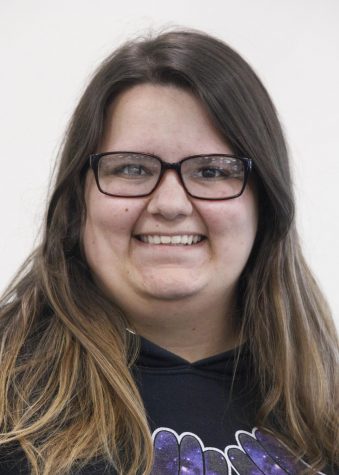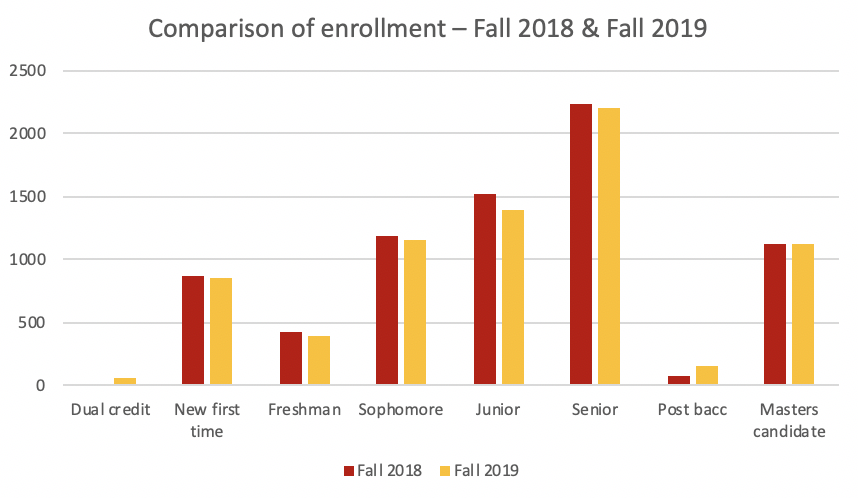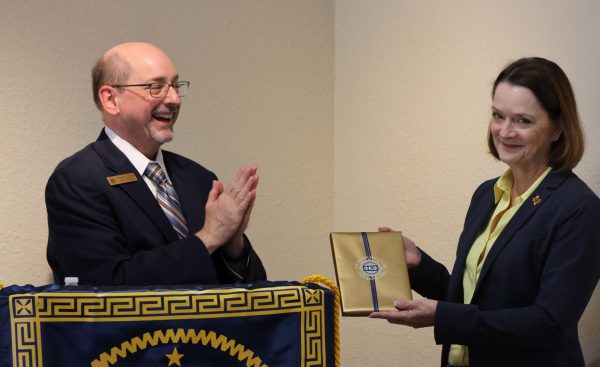Fall enrollment down from previous year
Fall 2019 enrollment has gone down despite the university’s efforts to increase it. However, the new recruitment practices seem to be working, according to President Suzanne Shipley, who said the fall 2019 incoming-freshmen class was the second-largest enrolling class.
Shipley said, “The new students are doing great. We have our second highest new-student number and our retention was higher so the things we’ve implemented on recruitment and retention are working well. It’s just the blips are hurting us, then with retention you have these demographic shifts.”
The blips she is referring to are the two areas where enrollment was low. The one that hurt the university the most is the current junior class. This class was one of the smallest incoming classes two years ago and caused the university to have 200 fewer juniors than the previous year. The second area is with transfer students.
“There are two main areas where it was really low. The first is the transfers. What we normally do is if we see a pattern we ask all of our colleagues if they are seeing the same pattern. Across the state, the numbers of transfer students were generally down. Most of our colleagues were down in transfers and so were we,” Shipley said.
With the past two commencements being the university’s largest, having a smaller junior class will be apparent whenever they graduate.
“We continue to graduate more students each time,” Shipley said. “Every single commencement is our largest commencement. It’s a good thing, but you are losing students that you have to replace, and if you hit a class that is down to begin with, then you’ve got between 300 to 400 students you have to replace as well as recruit [more] to stay up.”
The overall goal for the university is to continue to grow, but it didn’t. The Board of Regents and administration was disappointed. Shipley said the things they have implemented on recruitment and retention are working well.
“We believe we set a lot of stuff in place that will ultimately cause that number of students to increase, but it hasn’t happened yet. We will keep pushing,” Shipley said.
Demographic and financial shifts make it harder to recruit when combating the lack of transfer students.
“We all believe that it’s going to be harder to recruit students, particularly transfer students. They are going straight from community college into the job market because the job market is better now and salaries are better,” Shipley said. “Anytime the economy improves or the job forecast improves, you have to fight harder to get students.”
To help increase enrollment, the university is looking for more degrees targeting working individuals. A lot of the classes targeting these individuals would be located online or at the Flower Mound campus.
Shipley said, “That’s why you want more than one campus and more than one approach. We want to keep this residential campus strong, but we want to create a new pathway for the high school students taking dual enrollment, and we want to cap it off, not just with graduate degrees, but with degrees for working adults in the Dallas areas. This is all fairly new for us so it takes a while for it to settle.”
At the Board of Regents meeting on Feb. 4, Fred Dietz, vice president of enrollment, said the fall 2018 numbers fell 100 students short of the spring 2018 semester. One positive statistic in these numbers was the slight increase in students from fall to spring.
To combat the loss of students, many things were put into place. One of those being the new dual-credit system. This system lets high school students gain college credit at a discounted price. For the fall 2019 semester, there was an increase in dual-credit enrolled individuals increasing from eight students to 56.
Shipley also said she is expecting the dual-credit enrollment to increase exponentially over the next few years.

Alyssa Mitchell is the former Chief Editor of The Wichitan. She graduated with mass communication with a minor in PR and advertising. She worked as part...







